I have a deep interest in the work of Gaillard — they made copper pots from the early 1800s to the 1980s and their early pots are considered real masterpieces. I have a few of them, and I’m curious about how the look and craftsmanship of Gaillard evolved over the century of its work. I’m going to use this post to take a close look at each of my Gaillard pans and try to establish a chronological order for the marks.
About Gaillard
TJFRANCE has a Gaillard history page at his store’s website and it’s worth a look. TJFRANCE describes Gaillard not as a single company but as a house that encompassed multiple family-run workshops. Gaillard claimed to have been founded in 1795, but I found an even earlier mention of chaudronnerie Gaillard in Paris in 1761.
In 1815, Gaillard, fabricant, entreprend toutes sortes de chaudières de toutes formes et dimensions (“manufacturer of all shapes and sizes of boilers”) operated from 16 rue Saint-Jacques-la-Boucherie. The company grew steadily over the decades that followed: in 1820, there was a second location at 151 rue Mouffetard, and by 1839, there were a total of four. Of the four, “A. Gaillard” at 87 Faubourg Saint-Denis relocated to 81 Faubourg Saint-Denis by 1862, and appears to have been the antecedent of the well-known atelier.
After that point, commercial records show the company’s name changes over time.
- In 1873, the company changed name from “A. Gaillard” to “Gaillard fils.”
- In 1892, the name changed from “Gaillard fils” to “Gaillard.”
- In 1903, the firm was known as “J. and E. Gaillard.” I believe this was Jules and Émile Gaillard.
- Sometime between 1914 and 1920 there was a split: Émile operated a kitchenware and hardware store at 28 Faubourg Poissonière while Jules remained at 81 Faubourg Saint-Denis as a chaudronnier.
- By 1924, Émile Gaillard’s store was no longer advertised. The latest business record I can find is a shop invoice dated 1927.
- Jules Gaillard continued to operate the company through 1938, the final year of commercial listings I can access online. The latest document I have seen with his signature is dated 1933.
- By the 1950s, the company was operating as Établissements Jules Gaillard et fils, implying that Jules had passed away and his son(s) continued to operate in his name.
- The company ceased operations in the 1980s.
I turned to genealogical records to try to find related Gaillards with the correct first names during this timeframe but I had little success. There were many Gaillards in and around Paris during this time but I didn’t find enough information during the crucial 1870s to 1920s time period. I did find an Émile Gaillard, manoeuvre, chaudronnier en cuivre (laborer, coppersmith) in Paris, but he was born in 1893 and would have been just 14 in 1907, which seems a little young to become a partner in the main Gaillard enterprise. I’ve had no luck pinpointing the “A.” or “Jules” during the timeline above.
But what little I have been able to find out nevertheless suggests a possible rough progression of stamps. Please note that this entails some guesswork on my part, and as always, I welcome corrections and additions to make this a more reliable resource.
| Business stage | Stamp | Wording | Notes |
| Pre-1890s? | 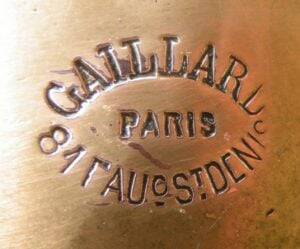 |
GAILLARD 81 FAUG ST DENIS, PARIS |
|
| 1890s(?) to 1903 | 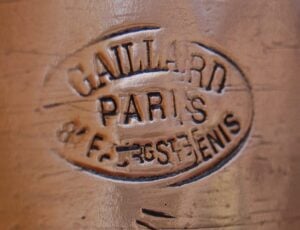 |
GAILLARD PARIS 81 FAUBG ST DENIS |
|
| 1903-1919(?)
Jules and Émile Gaillard |
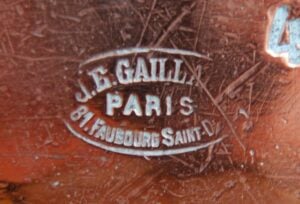 |
J. E. GAILLARD PARIS 81 FAUBOURG SAINT-DENIS |
Confirmed 1911 |
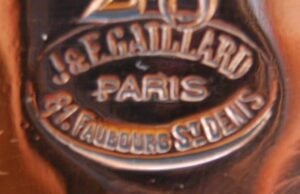 |
J & E GAILLARD PARIS 81 FAUBOURG ST. DENIS |
||
| 1920 to late 1930s
Jules Gaillard and J. Gaillard |
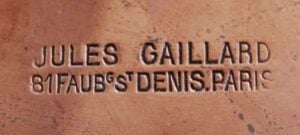 |
JULES GAILLARD 81 FAUBG ST DENIS, PARIS |
|
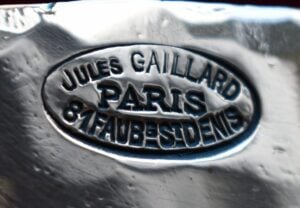 |
JULES GAILLARD PARIS 81 FAUBG ST DENIS |
Confirmed 1926 | |
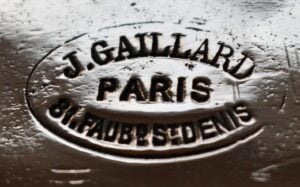 |
J. GAILLARD PARIS 81 FAUBG ST DENIS |
||
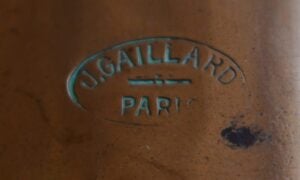 |
J. GAILLARD —– PARIS |
||
| Établissements Gaillard et fils
(Late 1930s to 1980s) |
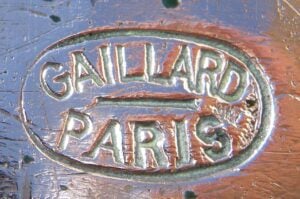 |
GAILLARD —– PARIS |
Apparently 1940s |
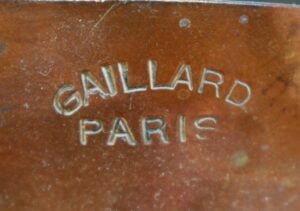 |
GAILLARD PARIS |
1950s?
See this warning about a replica stamp |
|
 |
GAILLARD — PARIS — |
Often seen on silver-lined orfèvrerie line | |
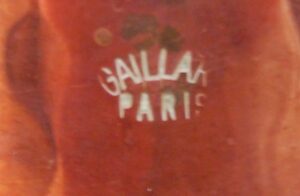 |
GAILLARD PARIS |
Later era, most likely manufactured by Mauviel for Gaillard |
Pre-1890s?: Gaillard with no oval
This stamp reads “GAILLARD 81 FAUG ST DENIS PARIS” with no enclosing oval. I think this is an early Gaillard mark, likely pre-1890s: the stamp has no oval enclosure and the pan itself has an early flat-profile cast iron handle. This could be a stamp during the A. Gaillard or Gaillard fils era, 1873 to 1892 or so.
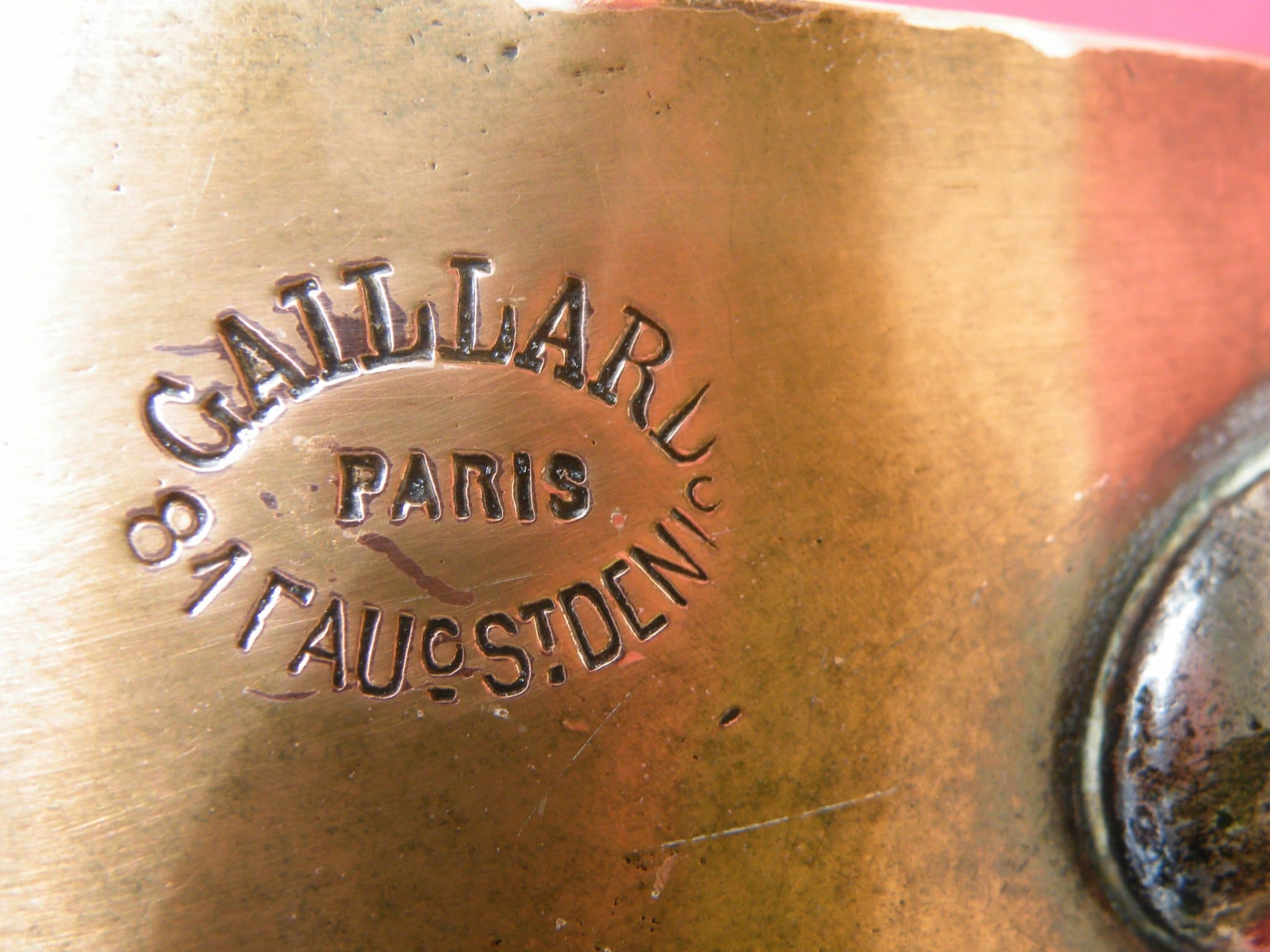
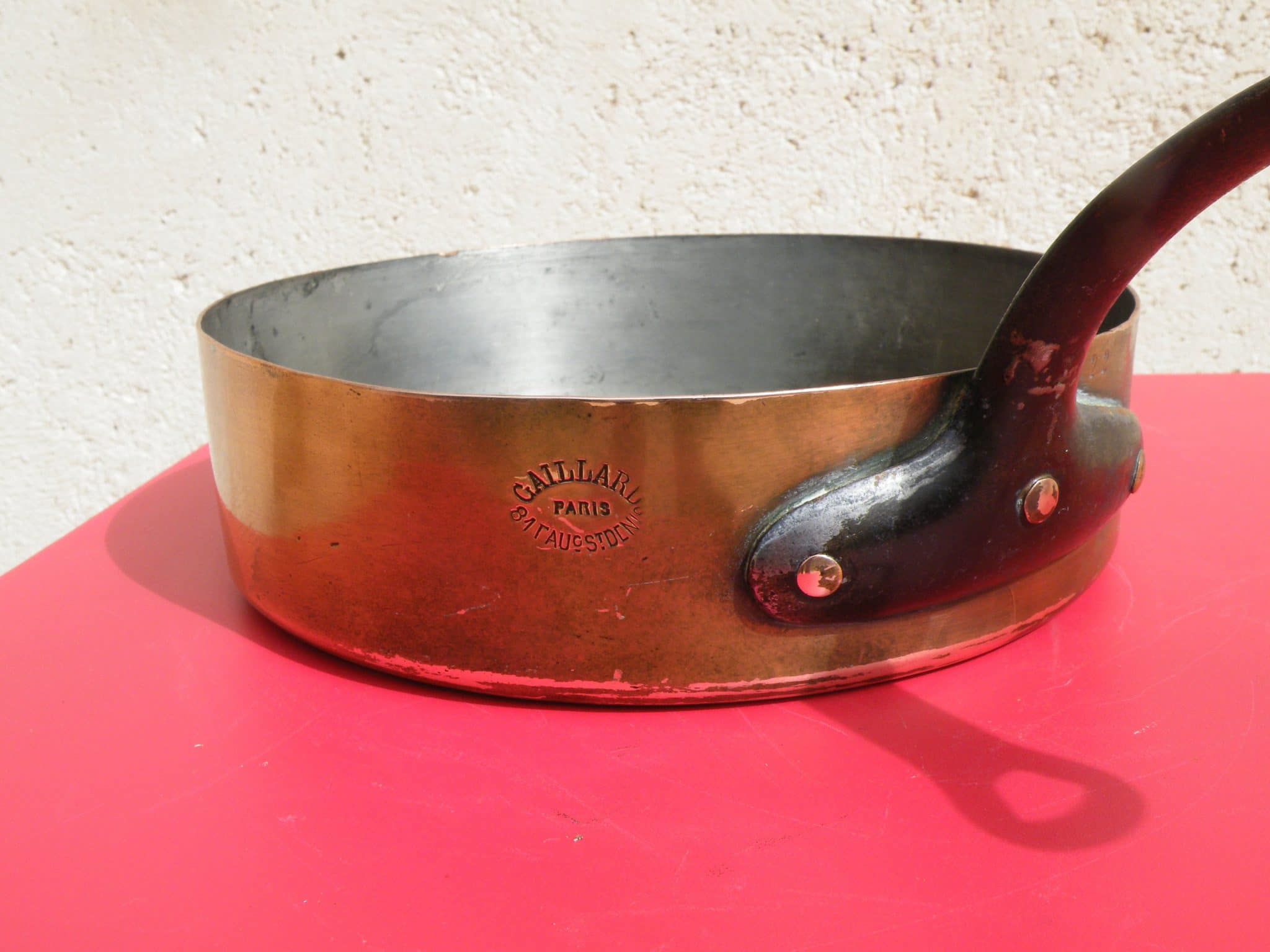
1890-1903: Gaillard oval
 This stamp reads “GAILLARD 81 FAUBG ST Denis Paris.” Stylistically, this is similar in its typography with the Gaillard stamp (tentatively pre-1890s) above.
This stamp reads “GAILLARD 81 FAUBG ST Denis Paris.” Stylistically, this is similar in its typography with the Gaillard stamp (tentatively pre-1890s) above.
This is the style of stamp on Stephen Whalen’s 46cm rondeau. I think that pan (and this stamp) are from right at the end of the dovetailing era and the beginning of the machine press era, 1890s to 1900s.
1903-1919(?): Jules and Émile Gaillard
As of 1903, Jules and Émile Gaillard had joined forces to operated the family firm together. The joint firm was listed in 1914 and then there is a gap in the records during World War I; when records resume in 1920, Jules and Émile had parted ways. Based on this, I estimate that these stamps represent work from 1903 to World War I.
I’ve seen two stamps that I think are from this era.
- J. E. Gaillard 81. Faubourg Saint-Denis
- J & E. Gaillard 81. Faubourg ST-Denis
The first seems to be more common than the second — I’ve only seen one example with the ampersand. Take a side-by-side look below.
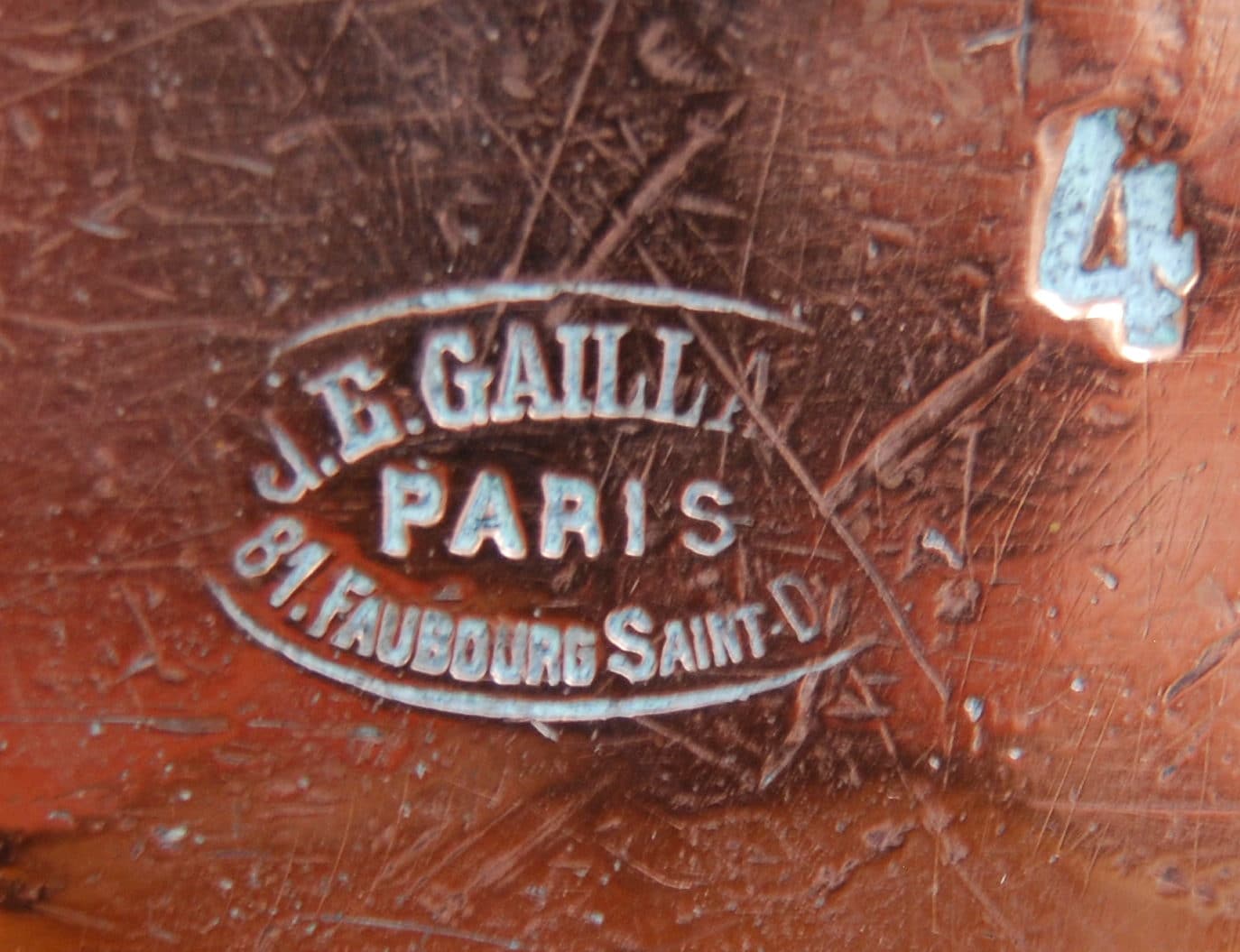

The pans I have with these marks, a 44cm sauté marked “J. E.” and a 36cm sauté marked “J & E.”, are both big heavy restaurant quality pieces. I don’t know why there are two versions of the J & E stamp that are so similar.
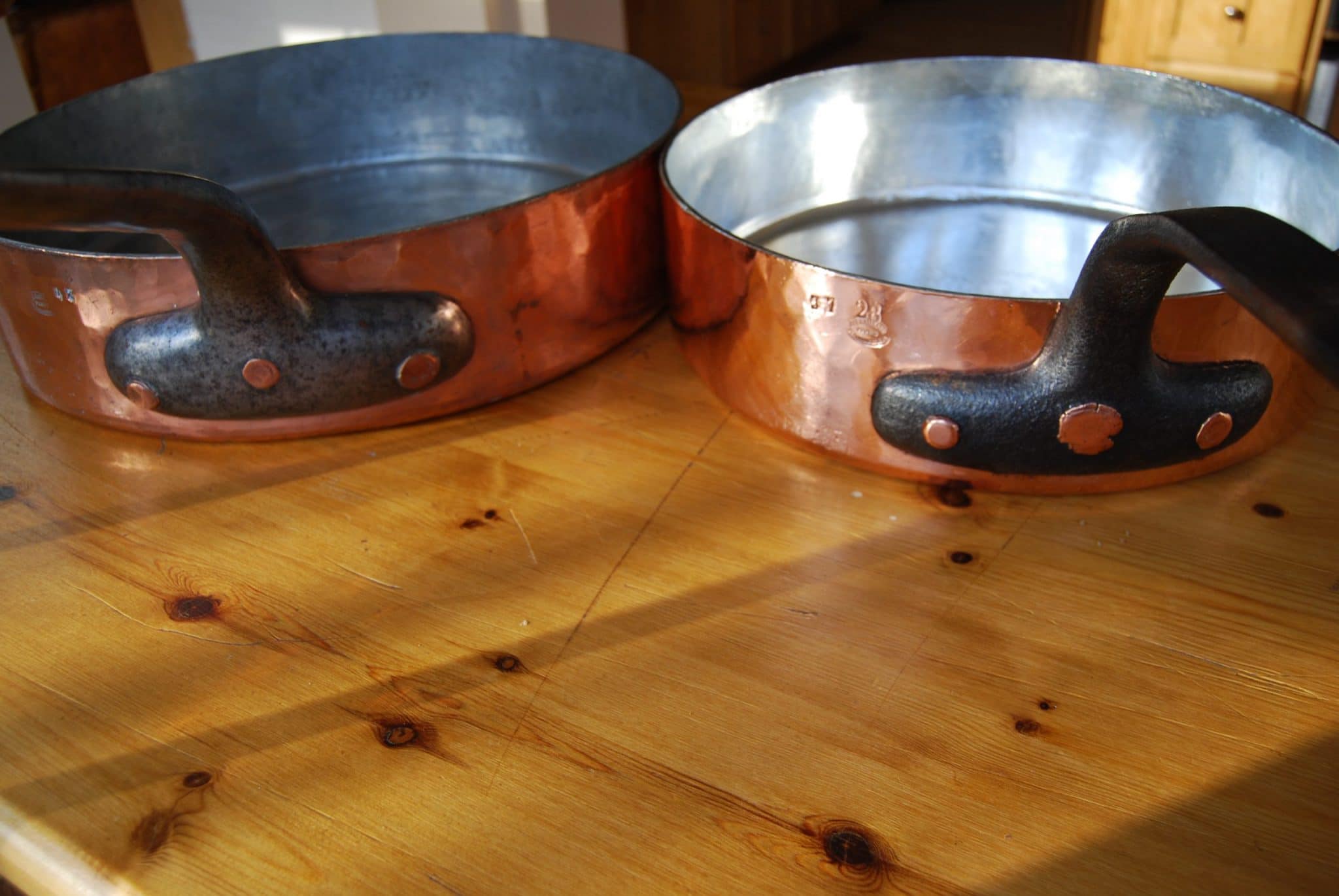
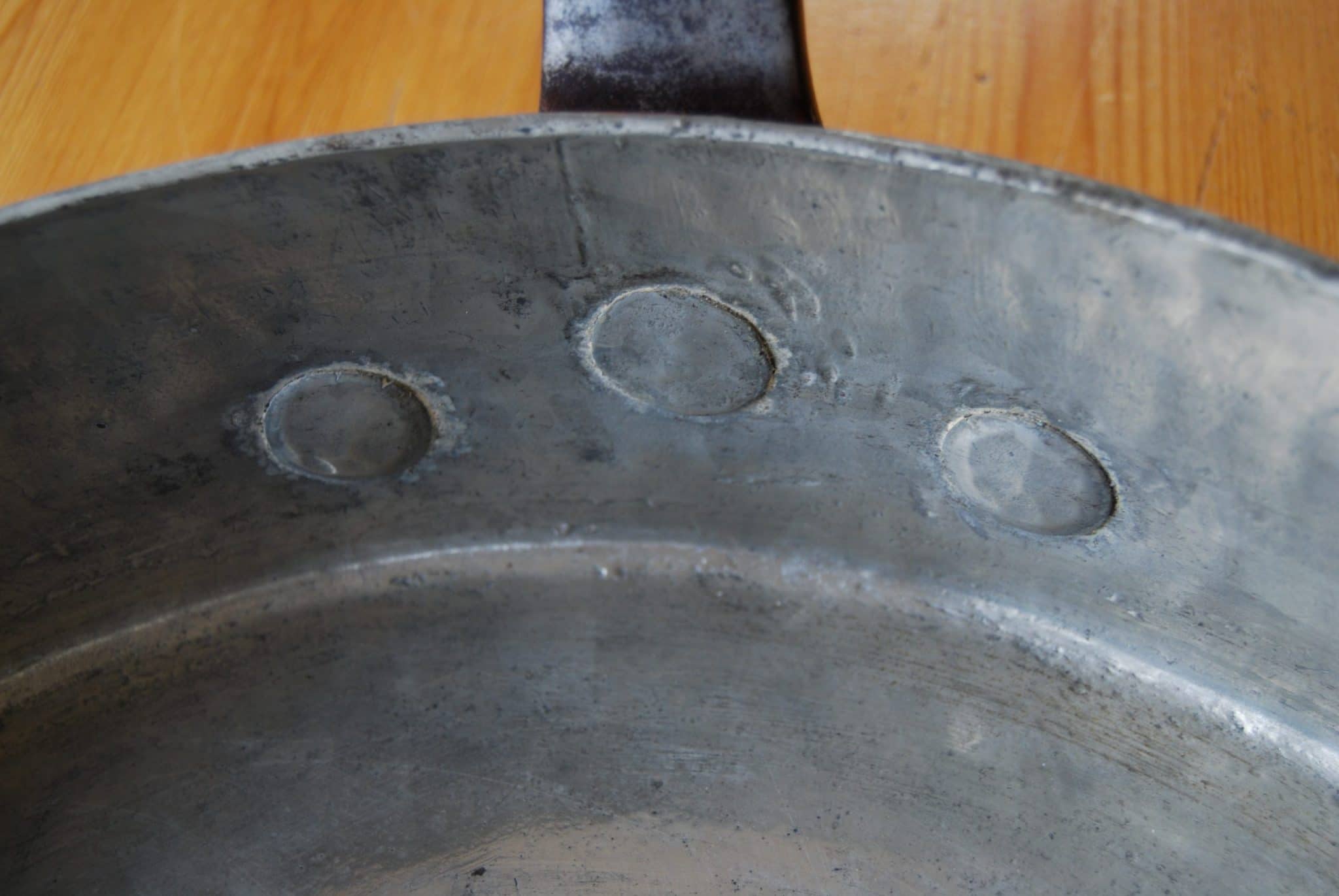
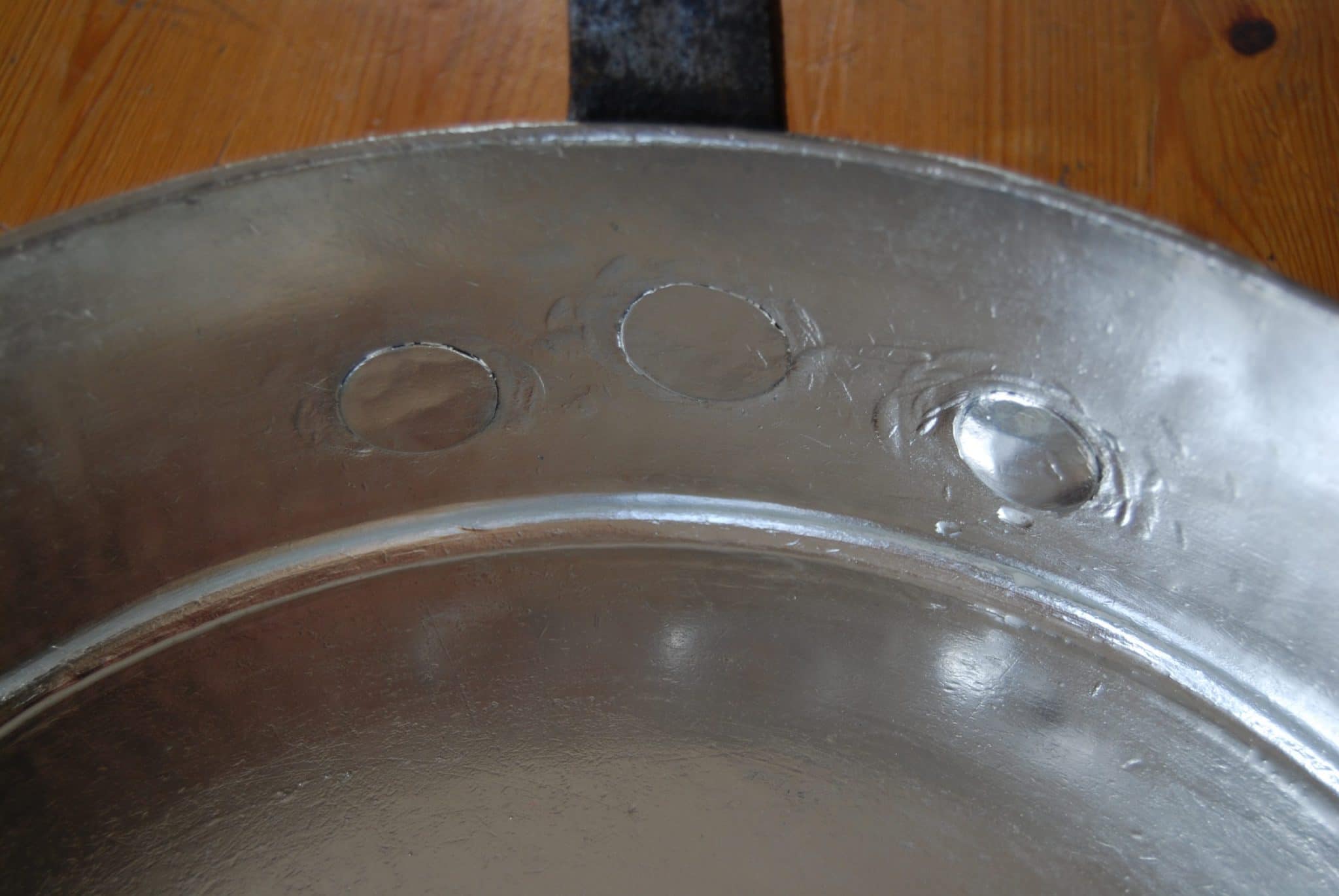
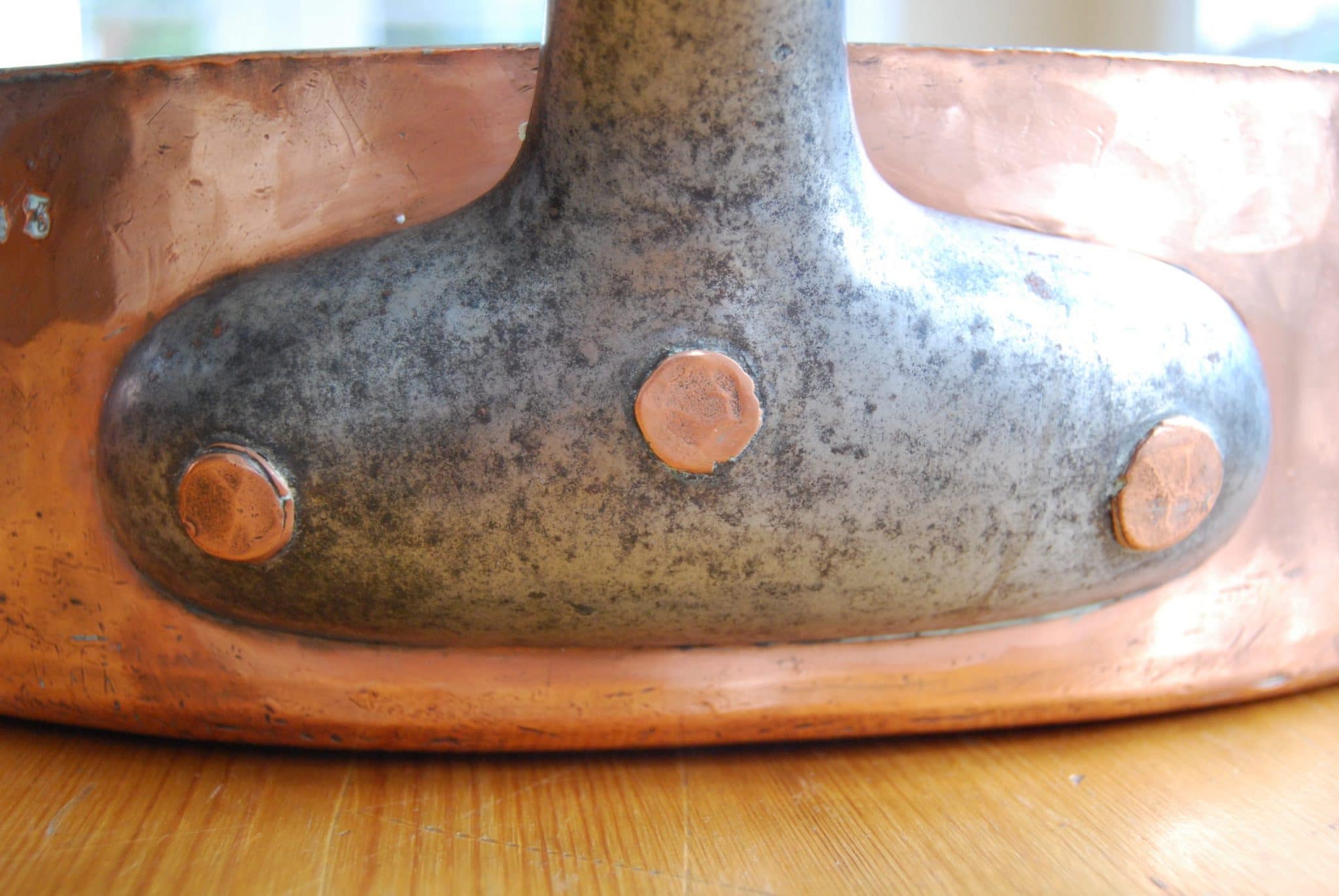
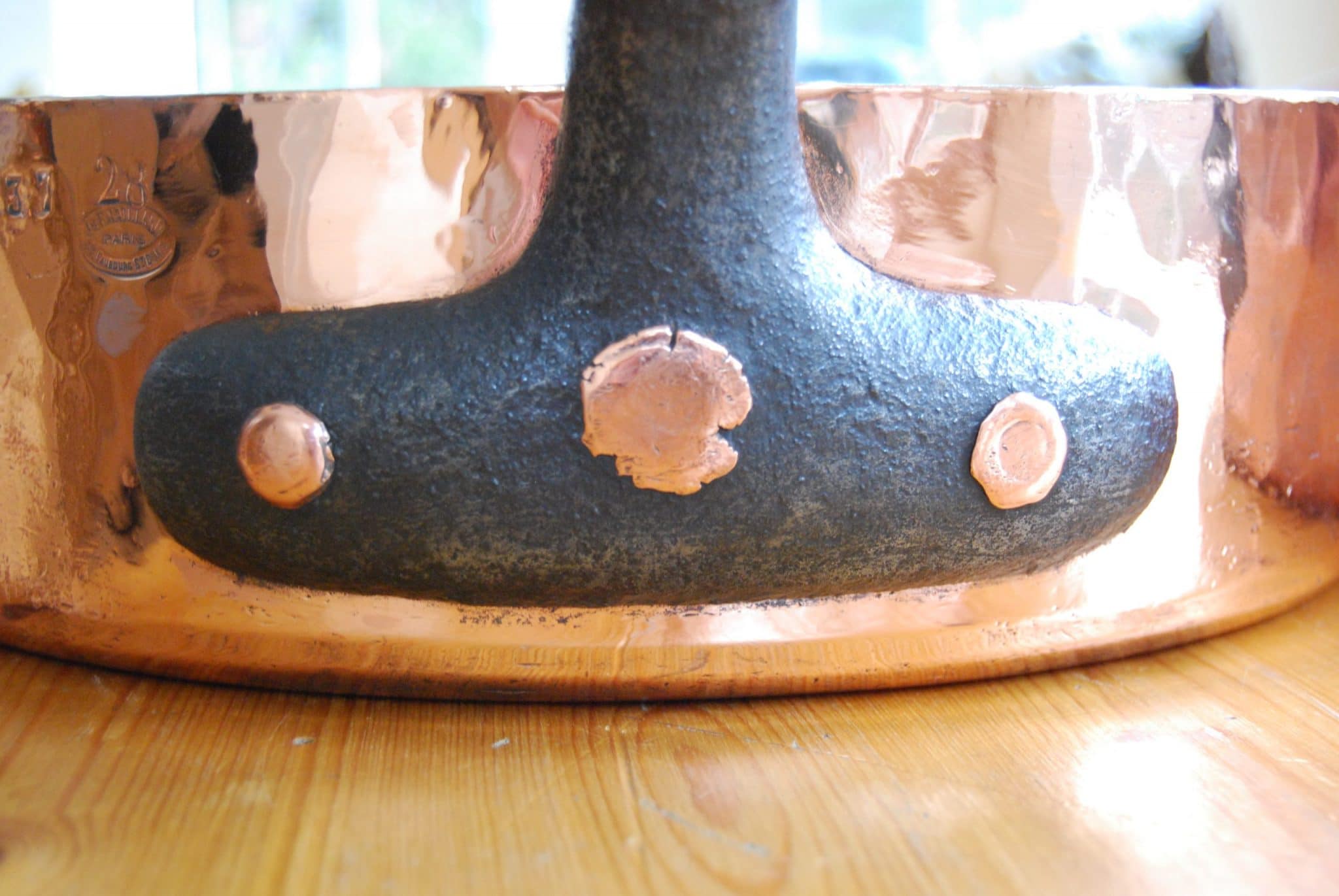
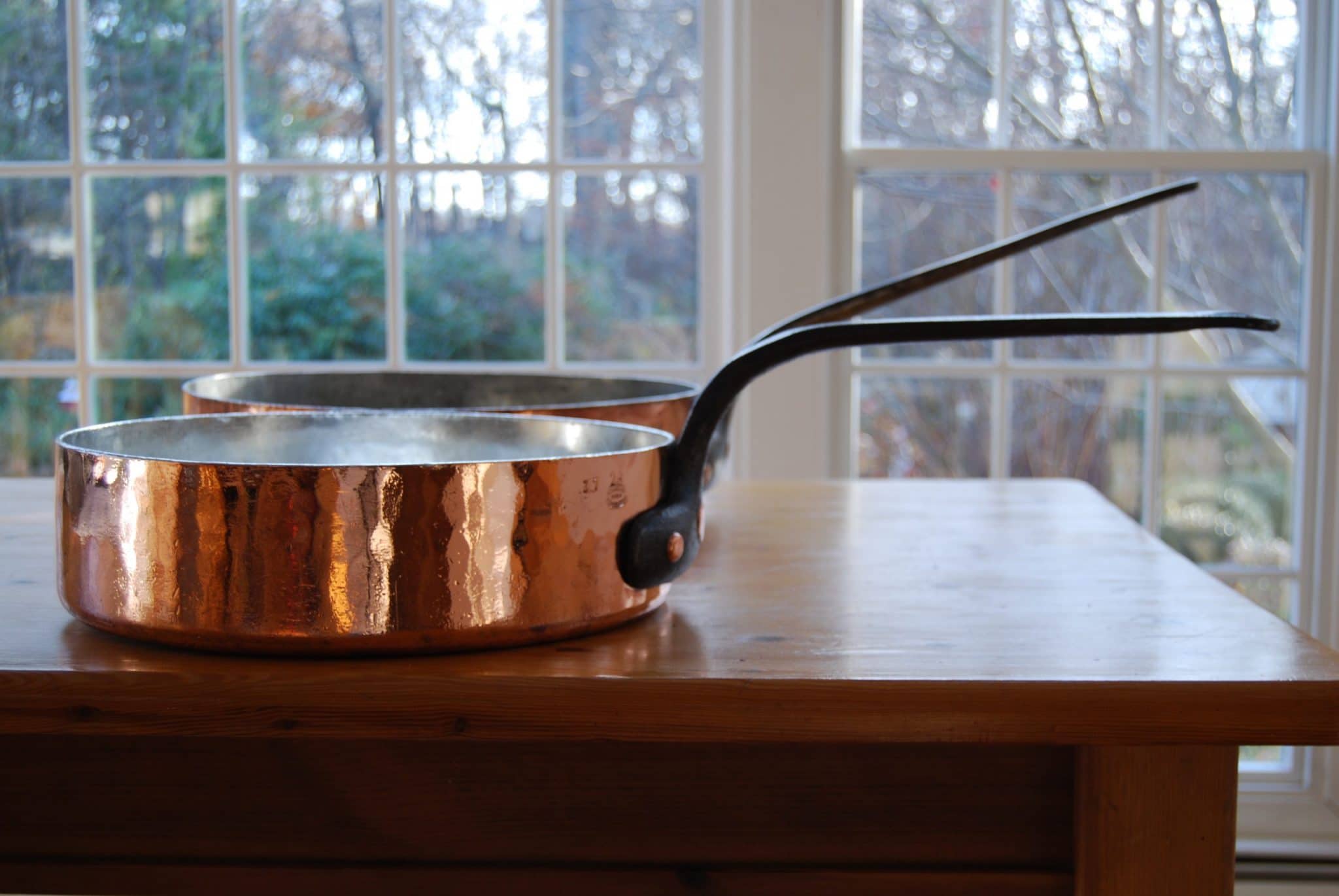
1920s to late 1930s: Jules Gaillard
Between 1914 and 1920 — during or just after World War I — Émile Gaillard split from Jules Gaillard to open a hardware store. Jules continued to operate the business as J. Gaillard, chaudronnerie et glacierie (coppersmith and refrigeration) until his death. I know he was operating the company in 1938 but that is the last reference I can find for him as head of the company.
 Jules Gaillard linear version
Jules Gaillard linear version
The linear version of this stamp says “JULES GAILLARD 81 FAUBG ST-DENIS. PARIS” in two straight lines. This is a fairly rare stamp — I have not seen many other examples of it online. I have one “Jules Gaillard” pan, a 30cm rondeau.
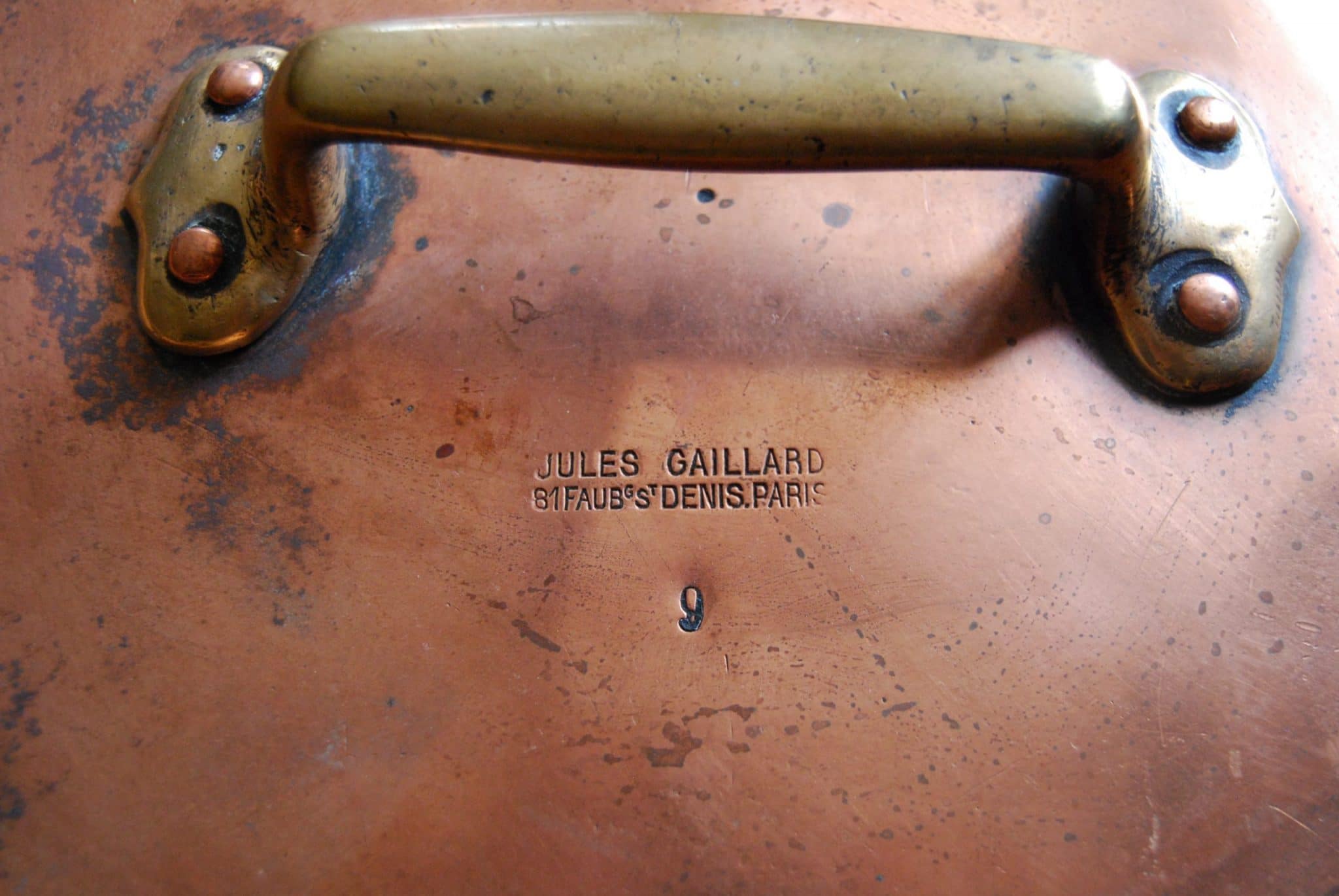

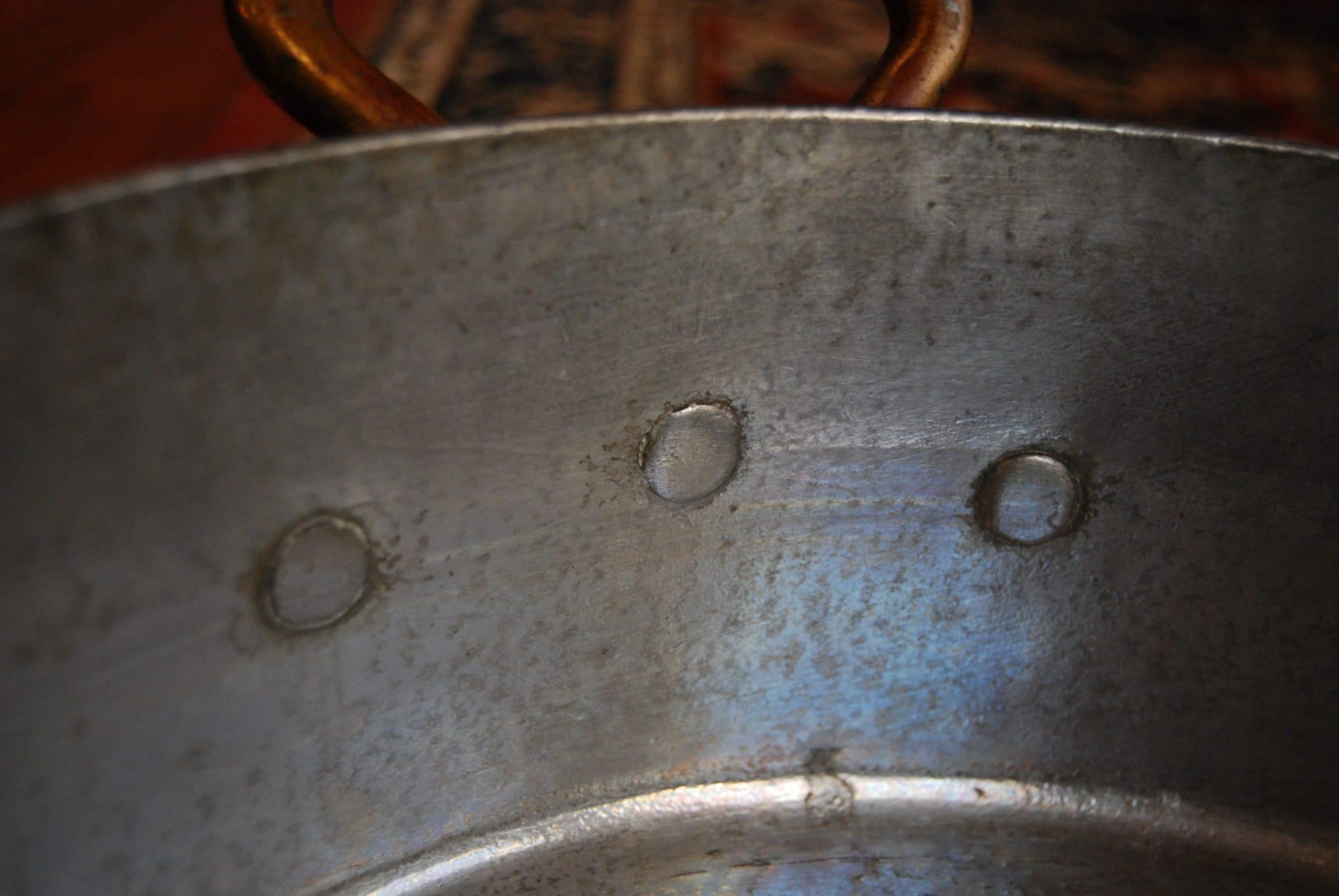
Jules Gaillard oval version

The oval version of the stamp is a cartouche reading “JULES GAILLARD 81 FAUBG ST DENIS PARIS.” This stamp is on an 18cm saucepan; it’s not dovetailed but is quite a bit thicker in the base than the sidewalls.
J. Gaillard oval with address
Between 1914 and 1920 — during or just after World War I — Émile Gaillard split from Jules Gaillard to open a hardware store. Jules continued to operate the business as J. Gaillard, chaudronnerie et glacierie (coppersmith and refrigeration). I believe this oval stamp represents production right after this split.
The stamp reads “J. GAILLARD 81 FAUBG ST DENIS PARIS” with fonts and abbreviations in the address that most closely resemble the Gaillard oval of the 1890s-1900s. Below are two examples of this mark; I think the very slight differences between the two impressions indicate that different physical stamps produced them. (My thanks to the eagle-eyed Fidelma Cox of Normandy Kitchen Copper for providing this second example stamp.)
 |
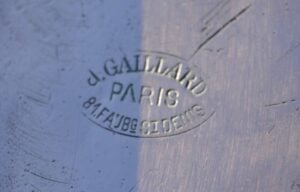 |
I know it’s a fool’s errand to try to base this chronology solely on visual similarities between stamps but at the moment I don’t have much else to go on. But the pans I’ve seen with this stamp are certainly early 20th century showing craftsmanship from machine presses, later than the Gaillard-only stamp.
 J. Gaillard Paris oval
J. Gaillard Paris oval
This stamp has “J. Gaillard” at the top, the word PARIS below, and a broken dash mark in between, all enclosed in an oval. I only have one pan with this mark, a little silver-lined pan de truite. It’s dovetailed, but note that an oblong pan like this would have to be — I believe these are still pieced together to this day, though now with welded seams instead of dovetails. This is an example where dovetailing does not mean the pan was 19th century — one has to consider the entire pan.
The 20th century styling on the pan example I have, the name “J. Gaillard,” and the simpler and more modern styling of this stamp lead me to believe that it marks production towards the middle of the 20th century, perhaps the late 1920s into the 1930s. I don’t know the dates of Jules Gaillard’s life but he operated the company until at least 1938; I suspect this stamp was the last version used during his lifetime before the company became known as Établissements Jules Gaillard et fils.
1940s: GAILLARD PARIS oval
I suspect this is the first Gaillard stamp used after Jules Gaillard’s death when the company became Établissements Jules Gaillard et fils. This stamp is stylistically similar to the J. Gaillard oval above. The typeface is simpler — minus the J, of course — and the horizontal divider between GAILLARD and PARIS is a solid line and not the more ornate flourish of the one above.
 I have a large unrestored 50cm stewpot with this stamp. This pot exhibits some of the same qualities we’ve seen in the previous examples: a handle base plate with a downward curve and pronounced decorative point, small rivets with impact marks, and flattened but not flush internal rivets. These are signs to me of machine-assisted work in the 20th century.
I have a large unrestored 50cm stewpot with this stamp. This pot exhibits some of the same qualities we’ve seen in the previous examples: a handle base plate with a downward curve and pronounced decorative point, small rivets with impact marks, and flattened but not flush internal rivets. These are signs to me of machine-assisted work in the 20th century.
 Post-WWII to 1980s: GAILLARD PARIS
Post-WWII to 1980s: GAILLARD PARIS
GAILLARD PARIS arch, large
Based on the style of this stamp and the construction of the pieces I see that carry it, I think this stamp represents work in the 1930s and 1940s.
I have recently become aware that there are two near-identical versions of this stamp appearing on vintage copper on eBay and Etsy. I have posted a statement on this matter. My current opinion is that one version, which I call Type 1, is a genuine Gaillard stamp. At this time I cannot verify the legitimacy of the other version, which I call Type 2. You can tell them apart by the alignment of the letters as shown below.
Type 1: Genuine Gaillard |
Type 2: Unverified origin |
 GAILLARD PARIS arch, large with dashes
GAILLARD PARIS arch, large with dashes
This stamp looks a heck of a lot like the Large arch version above but it is a different stamp: it has dash marks alongside the word “Paris,” and the spacing between the lines is narrower.
This is a fairly rare stamp. I’ve only seen it on a few pieces, all obviously post-WW2 — welded, lathe-spun, decorative rather than cooktop pieces. They feel to me like Villedieu work from one of the smaller shops, but this is a gut feel and I have no other examples from which to guess.
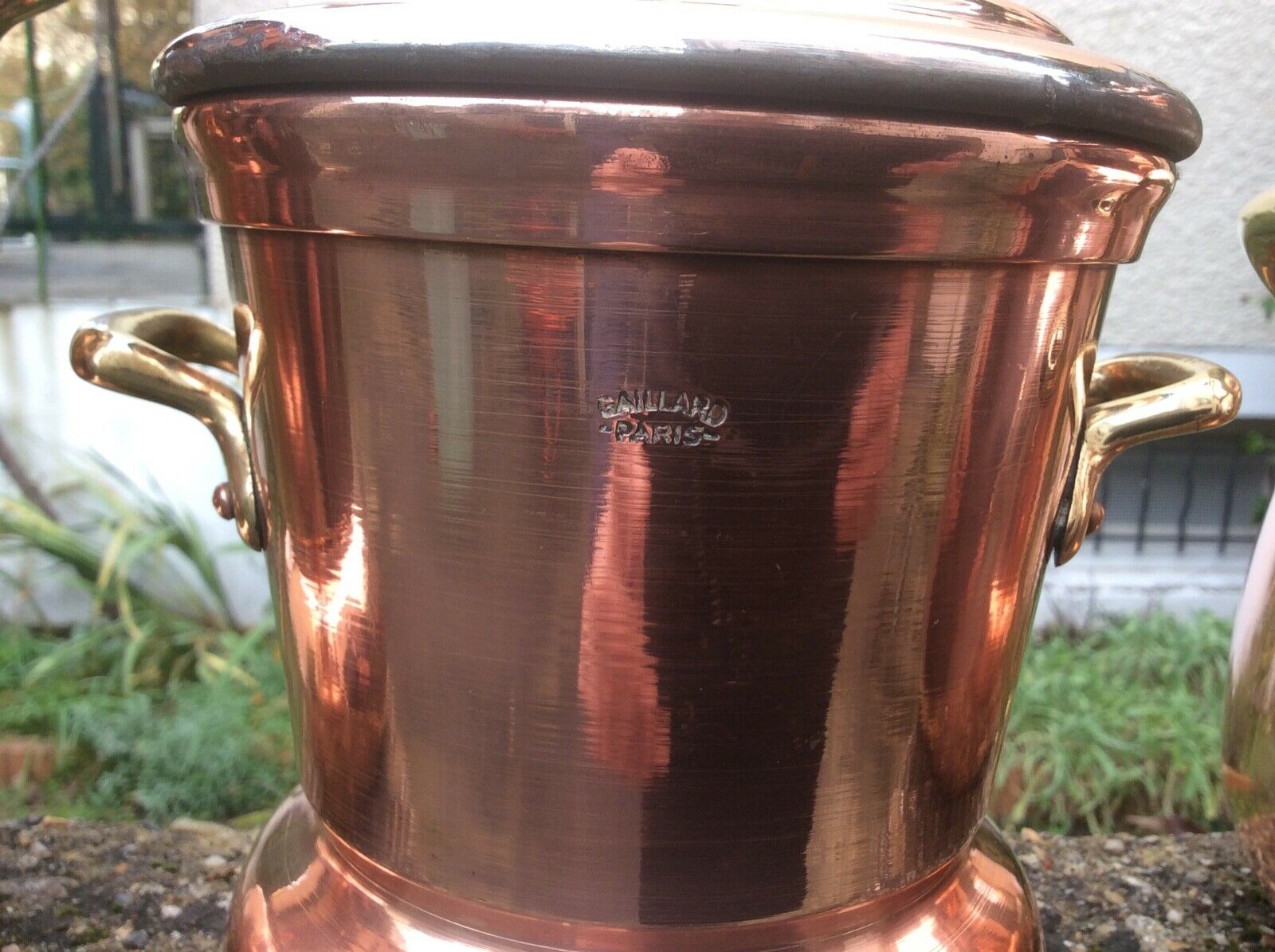

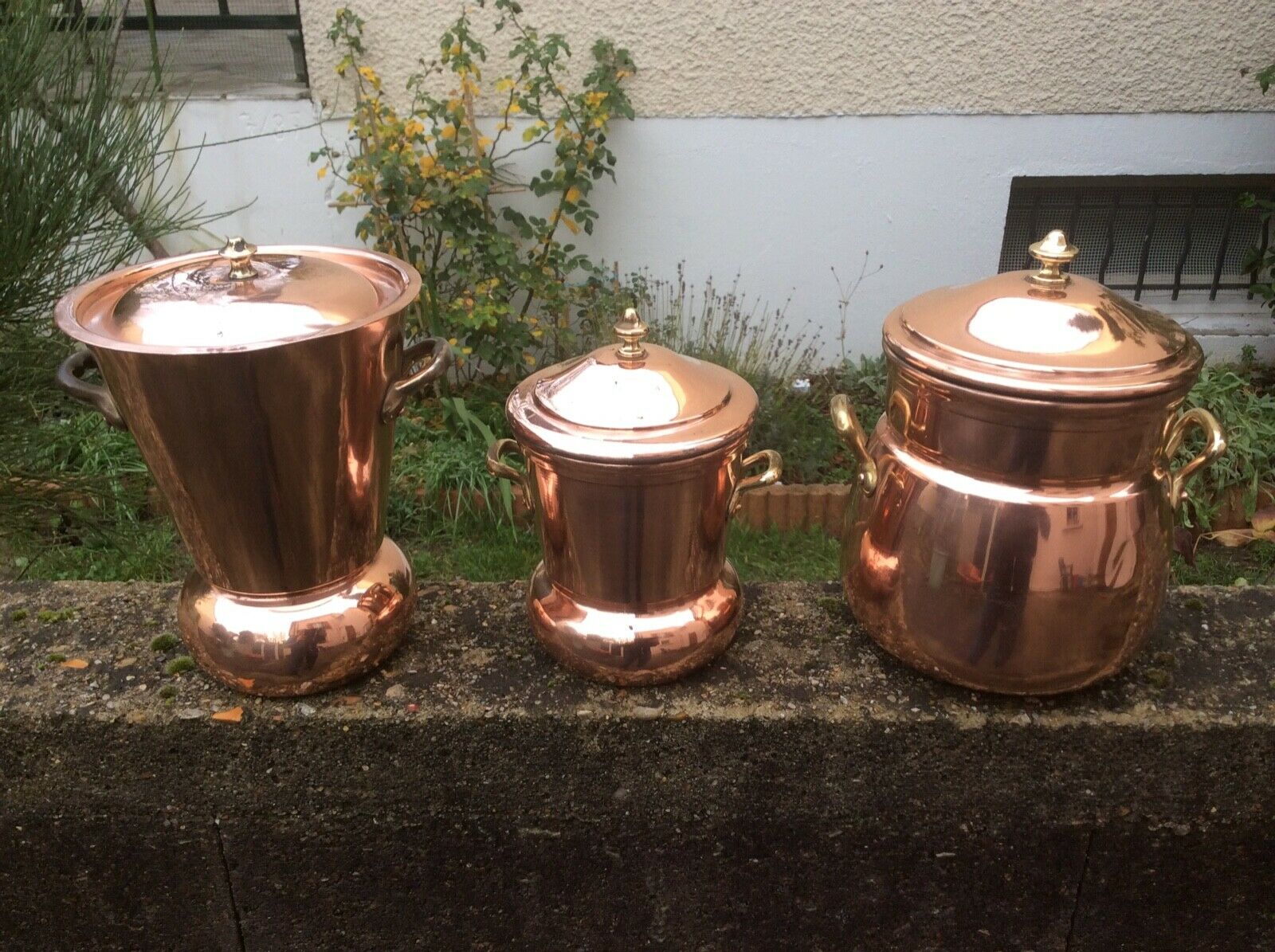
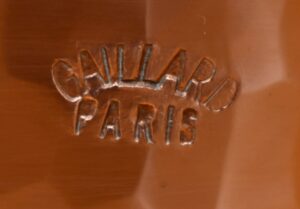
GAILLARD PARIS arch, small
This stamp shares the same arched shape, but the letters of the stamp are narrower and more closely set than the others.
I see this stamp on pots that also have the “Made in France” stamp, which suggests they were made after 1957 up until Gaillard closed its doors in the early 1980s. This is a relatively common version of Gaillard stamp, again suggesting to me that it’s recent; for example, it’s the stamp on my daily-use set of saucepans. The exterior rivets are rounded, with no impact marks. The interior rivets are rounded and have numbers on them.
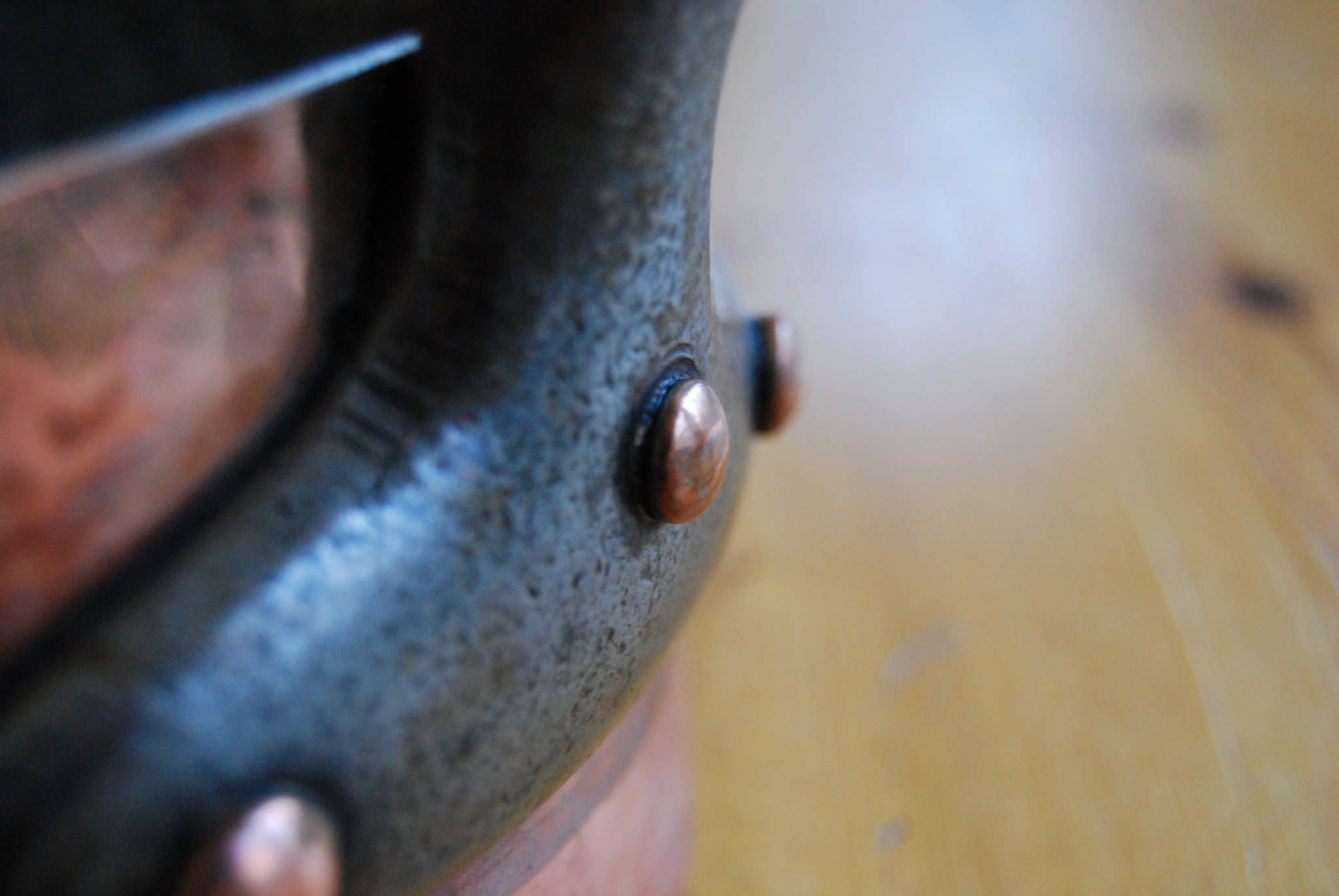
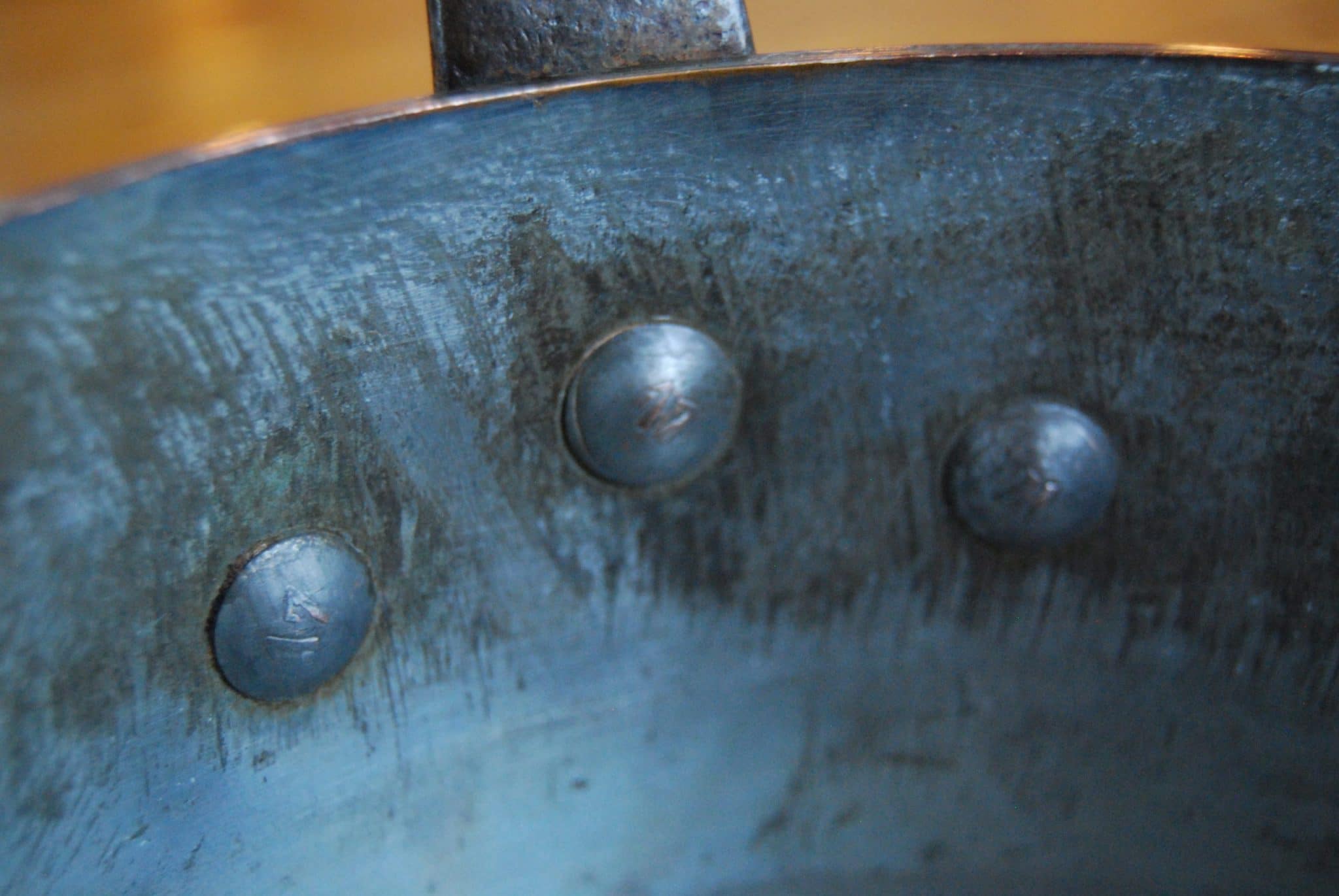
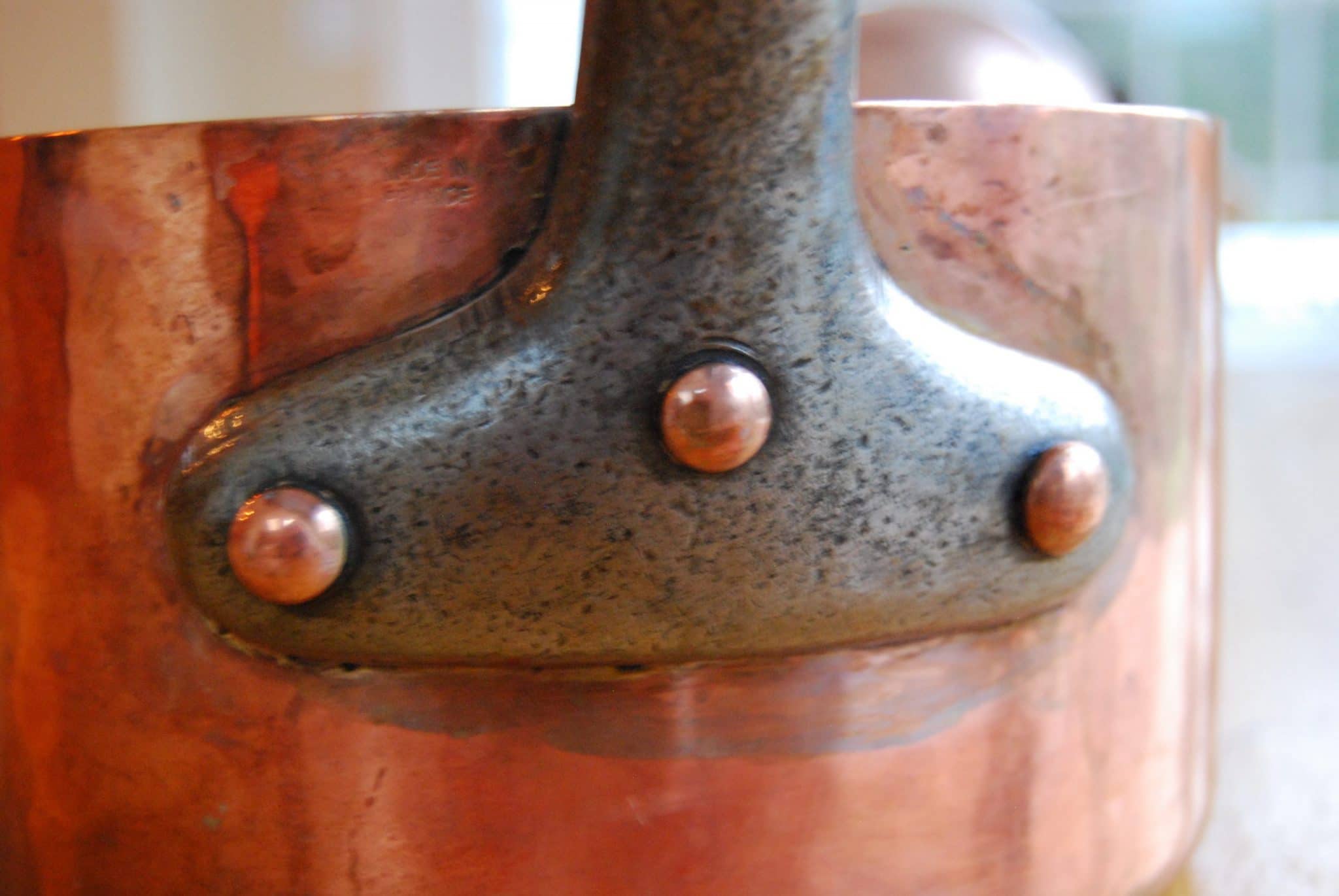
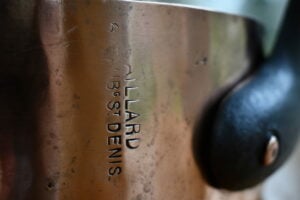 Mystery stamp
Mystery stamp
This is quite a rare stamp and I am indebted to reader Hannah for bringing it to my attention. It reads “GAILLARD 81 FAUBG ST DENIS” on two lines; there is no “Paris”.
This is the only example of this stamp that I have seen. Stylistically it is similar to the linear Jules Gaillard version, but it is definitely a different physical stamp. Would Jules have produced a second iteration of his stamp without his name? I don’t know.
Conclusions
I hope these stamp examples are helpful to you as you estimate the age of Gaillard pieces. As always, I apologize in advance for errors and omissions, and I welcome information you have that ties a stamp to a specific period of time: catalogs, advertisements, sales invoices, and so forth. Please reach out by email or in the comments — thank you!
Corrections
In November 2019, I went through and simplified this to make it more of a reference tool. I added a few stamps I’ve come across recently and updated some date estimates based on more research.
In October 2021, I revised the timeline to reflect emerging information (well, emerging to me, at least) that the linear and oval Jules Gaillard stamps were in use in the 1920s. This required reordering several stamps. I regret the error.
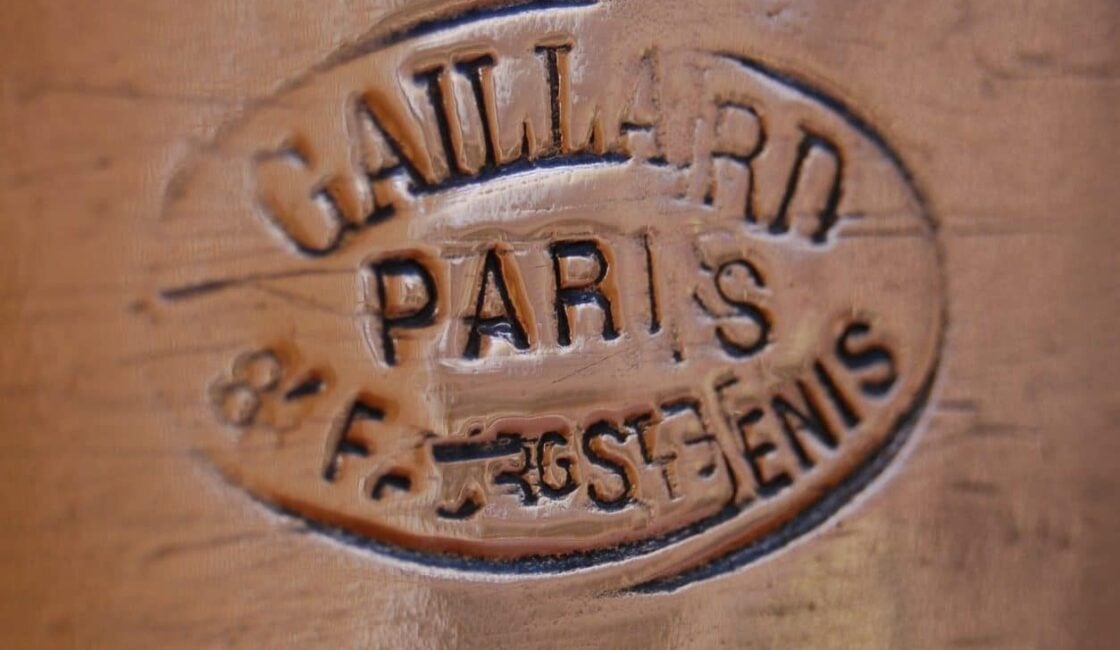
Such great information VFC! What a the chances of only the lid of a Gaillard piece would have the stamp on it, and not the rest of the pan ? Should one be worried ?
Thank you!
Tammy
Hey Tammy! It’s my experience that pans and lids are frequently separated over the years and it’s a rare and welcome phenomenon to find a matched pair that have stayed together. Are you concerned that a pan that you thought was Gaillard could in fact be something else? Take a good look at the condition and craftsmanship. Are the handle shapes similar? There are plenty of photos around this site of known Gaillard, so you have some examples of lids and pans. Do both pieces look similarly aged? Do they have any other stamps or markings in common? And finally, what is the fit between lid and pan? If they fit together like hand and glove, particularly if the piece is large, then it’s possible the maker didn’t think it necessary to stamp both. And feel free to reach out via email if you’d like me to take a look.
My copper pot also has the initials “RT” stamped opposite the Gaillard stamp. Is there significance to this?
Hi Gregory! Those initials are likely an owner’s mark — a person, perhaps, or a hotel or restaurant. Owner’s marks on copper helped keep track of pieces that were sent out for retinning or repair.
J. E. or J. & E. GAILLARD oval with address:
If I see two initials in front of a family name, I would assume that it is 1 person with two forenames (first and middle name). However, if the initials were separated by an ampersand, it can be clearly seen that there are 2 people with the same family name. Was the job to the stamp maker unclear?
The unabridged spelling of the street is clumsy and is not written in this way on any other Gaillard stamp on which the street is listed.
I am surprised that this “clumsy” stamp is more common than the version with the correct and more elegant spelling.
This so detailed, considered and helpful. Thank you.
Hi,
Just a little bump – check out the new field guide to Benham.
Dear VFC
Thank you for the thorough, rigorous research. I came across your blog when I was researching an old wooden ice box that came my way. It is marked Chilkoot (the Michigan manufacturer) and lined with tin plates. It also has a chipped white oval enamel sign with the name Jules Gaillard and the address 81 Faubg. St. Denis. I believe that the chipped top part was ‘’Glacières, Chambres Froides’.
Hello I have bought a large oval flat oven dish with Gaillard Logo 1 under the brass ring handle but also stamped EH on the side.
Can you enlighten me please? Kind regards, Lisa
Hi Lisa — My immediate thought is that it’s an owner’s mark. I may be able to be of more help if you can provide a photo — I’ll send you an email. Thanks!
Hello, this information has been so welcome with me! For ages I have been wondering about the origins of my pan. I have a question though. The (1890) Gaillard stamp is to the left of the handle, and then on the right side of the handle is another stamp. This stamp is a crown. Any idea what this crown could relate to? Doesn’t seem like I can post a picture of it alongside my posting? I have very detailed photographs of the pot and the markings, if you would want to see them.
Hey Linda! Thank you for your kind words. I’ll send you an email so you can respond with some photos and I’ll take a look.
Good morning,
I have Gaillard copper potato steamer. Sadly lacking it’s metal trivet. In looking at your website – which I found very interesting and helpful, thank you – I think my steamer dates to 1890’s/1903 following your date marks as a reference?
It’s weight is 1.9kg. The lid is lined with silver? Nickel? It is very bright and the lid weighs 543g.
The two brass handles on each side are each fixed with 3 copper rivets and the lid has a brass round knob.
It is a rather beautiful item.
Would you know if it is possible to obtain a trivet?
Many thanks
Linda Chawner
Regarding the oval Jules Gaillard stamp, I have just returned from Belgium with a collection of pans that a family member of the seller acquired at auction some 30 years ago. Then, they were attributed to the Grand Hotel Bellevue. However, there are 9 oval Jules Gaillard stamped pans and 1 Mson Van Neuss Pommier saucepan that are stamped for the WESTEND HOTEL…
https://imgur.com/a/BeUbot3
I’ve looked into the history of Westende a bit and this is what I’ve dug up so far. The resort town of Westende was developed by Albert Chambon and Édouard Otlet in the late 1890s. As well as planning the town and its amenities, they designed and built the Westend Hotel on the seafront, a luxury hotel hosting exhibitions and cultural events, it was very much at the heart of the resort popular with the Belgian Royal family at the beginning of the 1900s.
The thing is, the hotel was completely destroyed in 1914/15 as the German army pushed the Belgian army into the last corner of Flanders. Fighting over the Yser front, which met the North Sea at Westende, continued for most of the remainder of the war.
A new hotel, the Westend Palace was built on the site of the Westend Hotel, starting in 1919. One of the pans, a 26cm sauté, features the oval Jules Gaillard stamp, the WESTEND HOTEL stamp and the initials WP, presumably for the Westend Palace.
I’m aware that information suggests that Jules and Emile Gaillard were working together until the 20s, but I’m struggling to reconcile that with the date at which the Westend Hotel ceased to exist. Thoughts?
Alex, the two stamps are in excellent condition. Is this also true for the other stamps and especially for the pans themselves? Then I can heartily congratulate on your purchase. I would also be interested in the font of the WP stamp. Does it have the same typography as used on the Westend Hotel stamp?
T.J. France dates the end of the partnership between Émile and Jules as 1918. Jules remained at 81 Faubourg Saint-Denis as a chaudronnier, as also documented by VFC. http://www.francelorrainecollection.fr/GAILLARD-PARIS/
Unfortunately, I do not have my own sources and evidence.
Good morning Martin. I trust you are well.
I will take some pictures of the 26cm sauté as I think this is possibly the most “important” given the second stamp that helps with the chronology.
There was an unbranded sauté of 31cm with significant verdigris to the inside. The 26cm sauté has almost matching verdigris to the exterior base. Combined with the rust coloured water mark and the corrosion to the base of the handle, I believe the 26 spent some time sat in the 31 with water present.
As such, there is quite a bit of corrosion to the handle, though it is nothing that can’t be cleaned up.
What is remarkable, aside from tarnish and verdigris, is the physical condition of the copper. It has clearly not been as heavily used for as many years as pans of a similar vintage.
It is 4mm at the rim and very heavy. It has a set of beautifully formed bevels. The rivets are large and the centre one is a little domed. I feel like that one in particular has never been tightened!
The WP is very different, each letter being struck separately using a large stamp. It is like so many owners initials stamps, as opposed to the bespoke single stamp WESTEND HOTEL mark.
To my eyes, the hotel mark aligns with a time of opulence, versus what I think is the later WP stamp, representing a time between the two world wars, where items like these pans would be recycled to a new owner, rather than buying new.
The same Westend hotel stamp features on a Mson Van Neuss Pommier saucepan, giving further support to the hypothesis that these pans were indeed supplied to the hotel at some point after its construction in 1898 and its destruction in 1914.
All 11 of the gaillard pans have copper in remarkable physical condition. They are mostly flat and don’t show signs of a century of use. Several have very rusted handles.
The largest is a 40cm sauté with dovetailed base that weighs in at 11kg.
The only pan in the collection that gives me cause for concern is a 26cm saucepan that has significant rust to the handle, including behind the base, such as there is rust that has penetrated around the centre river to the inside of the pan. Not sure what I’ll do about that.
I’m almost ashamed to say that the price I paid feels like robbery, even accounting for a flight to Brussels and a 12 hour drive back home.
I know that VFC had pans stamped with the Jules Gaillard oval stamp that he felt were earlier than the now suggested 1920’s. One can never be 100% sure, but I do feel that this collection provides rather conclusive proof that the oval Jules Gaillard stamp was in use before WW1 and possibly as early as 1898.
What do you think?
(I’ll try and get some more photos of the collection together as soon as possible.)
Hi Alex, interesting, I’d like to see the pots if you can send me an email at [email protected]. I don’t think the stamp is quite as early as you’re thinking but I’m still curious.
Hi Joe, I did post a comment with links to the photos, but it seems to have been moderated out. I’ll try again.
Sautés – https://imgur.com/a/h3mu3wf
Saucepans – https://imgur.com/a/vLCRw0i
Windsors – https://imgur.com/a/l9gX5e6
And the Mson Van Neuss Pommier saucepan with the Westend Hotel stamp and a second stamp for the Grand Hotel Bellevue.
VN Pommier saucepan – https://imgur.com/a/D0FB7aa
Here are some photos. Apologies, I have made no effort yet to start cleaning these up. As you can see, the handles are quite rusted on most of these, but I believe these will be cleaned up nicely with a bit of effort. The copper on the other hand is in remarkably good shape. Only the 26cm sauté is very slightly out of round.
Sautés – https://imgur.com/a/h3mu3wf
Saucepans – https://imgur.com/a/vLCRw0i
Windsors – https://imgur.com/a/l9gX5e6
And for reference, here is the Mson Van Neuss Pommier saucepan that features the same Westend Hotel stamp.
VN Pommier saucepan – https://imgur.com/a/D0FB7aa
This one also features a second stamp for the Grand Hotel Bellevue. I have a later (20’s) H Pommier Windsor also stamped for the Bellevue hotel.
I am assuming that after the destruction of the Westend Hotel, these pans ended up at the Bellevue, perhaps via the Westend Palace.
I’m looking forward to cleaning these up and getting them tinned.
Let me know if you’d like any other photos.
Today I saw on ebay the offer of a very small Gaillard sauteuse évasée (12x4cm), hammered and with a beautiful bevel. But the most interesting thing was the stamp. It strongly resembles the stamp that VFC calls “GAILLARD PARIS, arch large type 2: unverified origin”. Also on the stamp found today, the imaginary line from the P goes through the A. But this stamp is immaculately executed. Together with the high quality workmanship of the pan, I assume the stamp is genuine. Unfortunately, another interested party snatched up this pan. I will send VFC photos.
Ok, i think I have it figured. One of the sources I was referencing erroneously suggested that the Westend Hotel was rebuilt as the Westend Palace after being destroyed in WW1. In fact, it was rebuilt larger and grander as the Westend Hotel again, then after sustaining heavy damage during WW2, it was subsequently demolished and rebuilt as the Westend Palace, which is still in Westende to this day.
So, it would seem that these were likely bought for the second incarnation of the Westend Hotel, right around 1920, which lines up a little better with current estimates.
Hi VFC! I just picked up a lovely little Gaillard saute and I’m trying to date it. It’s marked Gaillard — Paris within an oval, but seems to be a little older than 1940s based on everything else I’ve seen. I was wondering if you wouldn’t mind take a look and seeing what your thoughts were. Thanks!